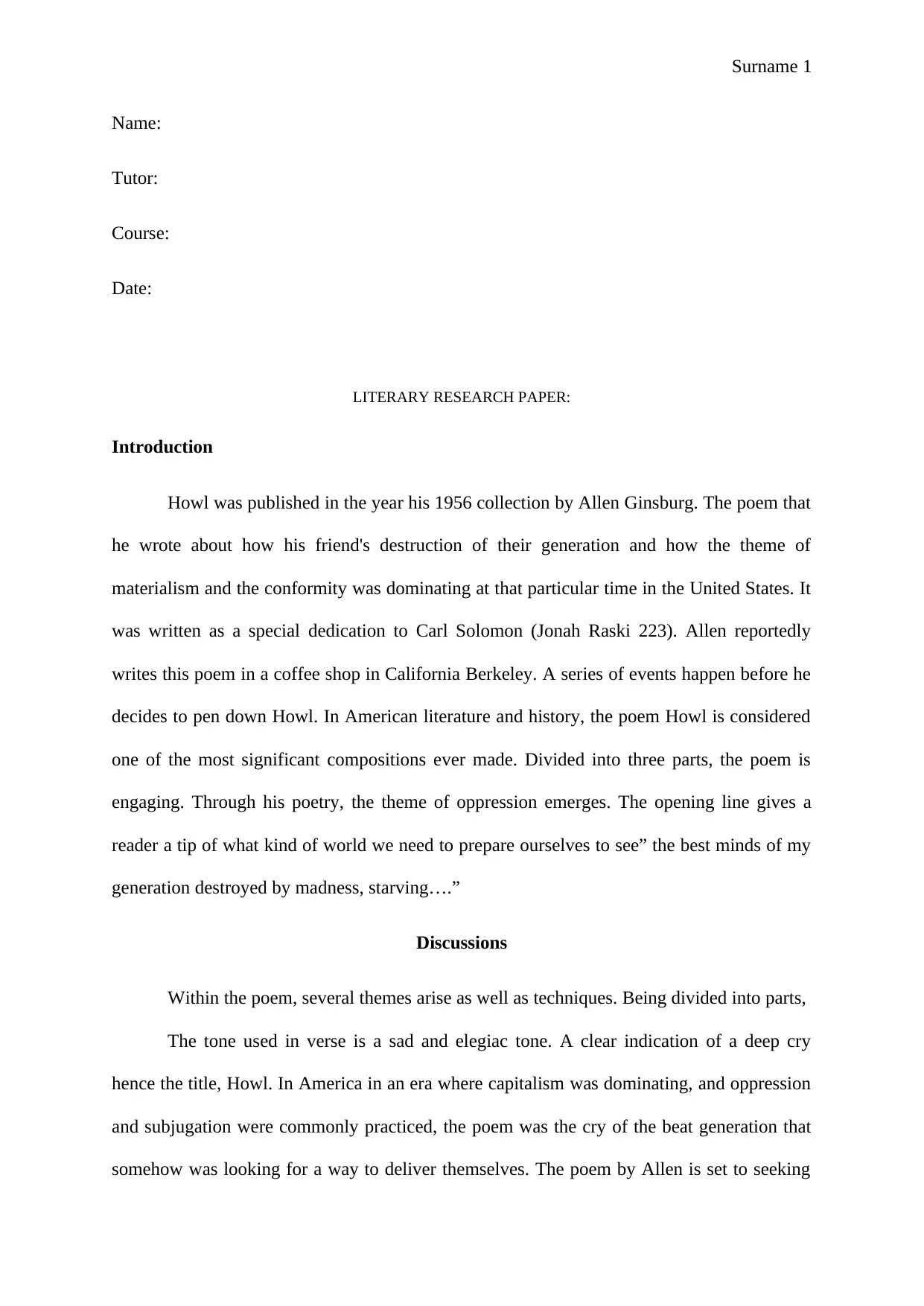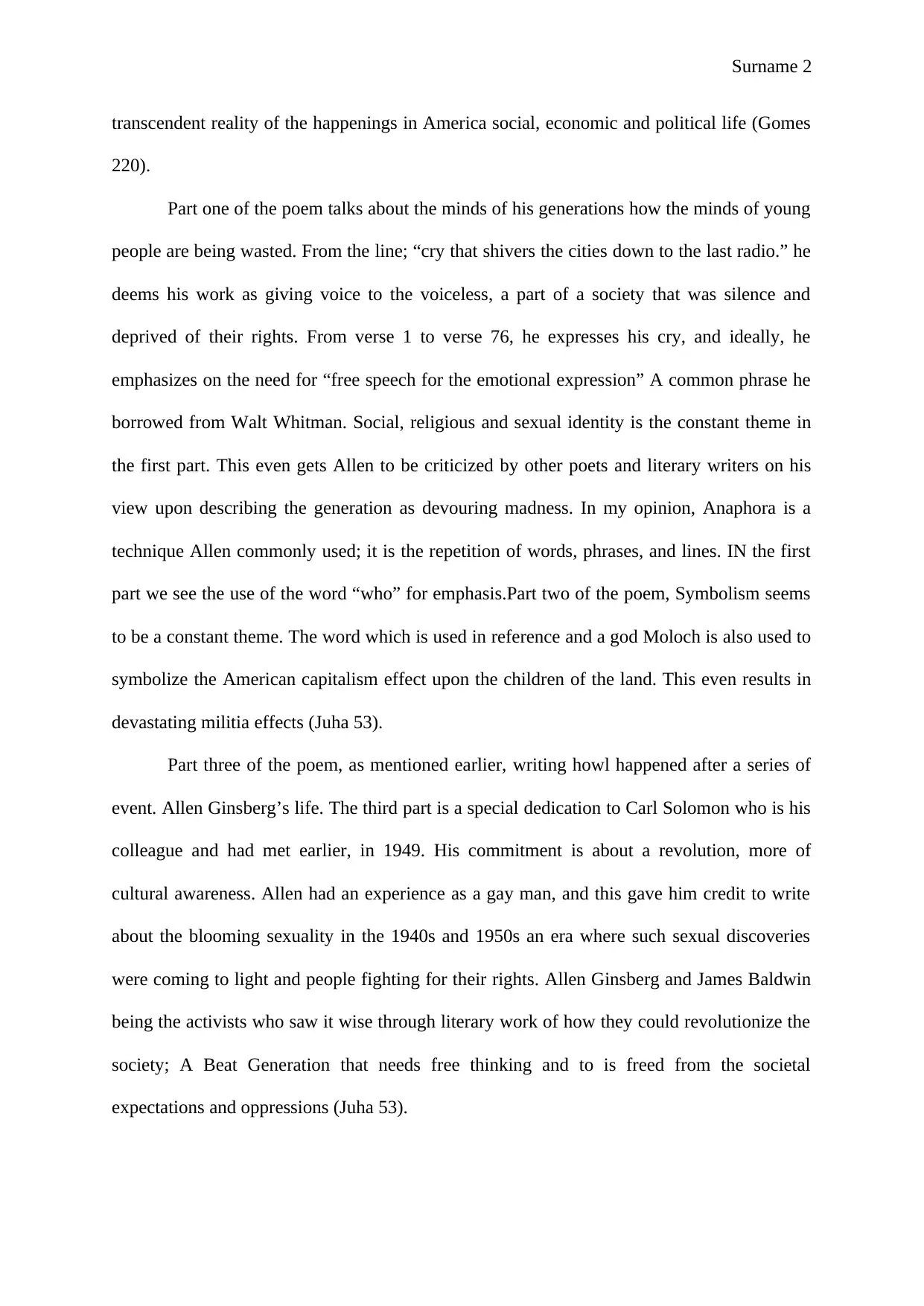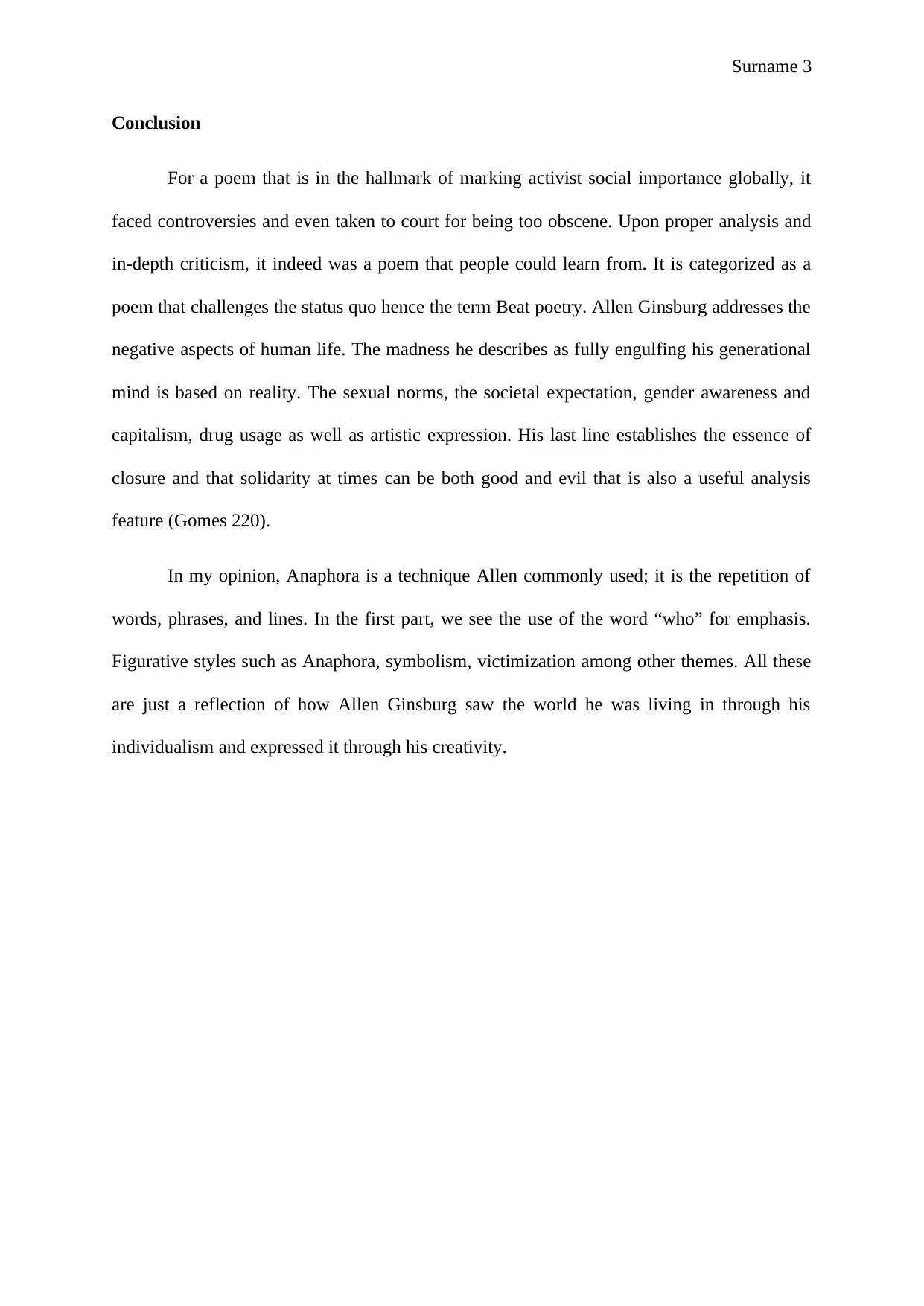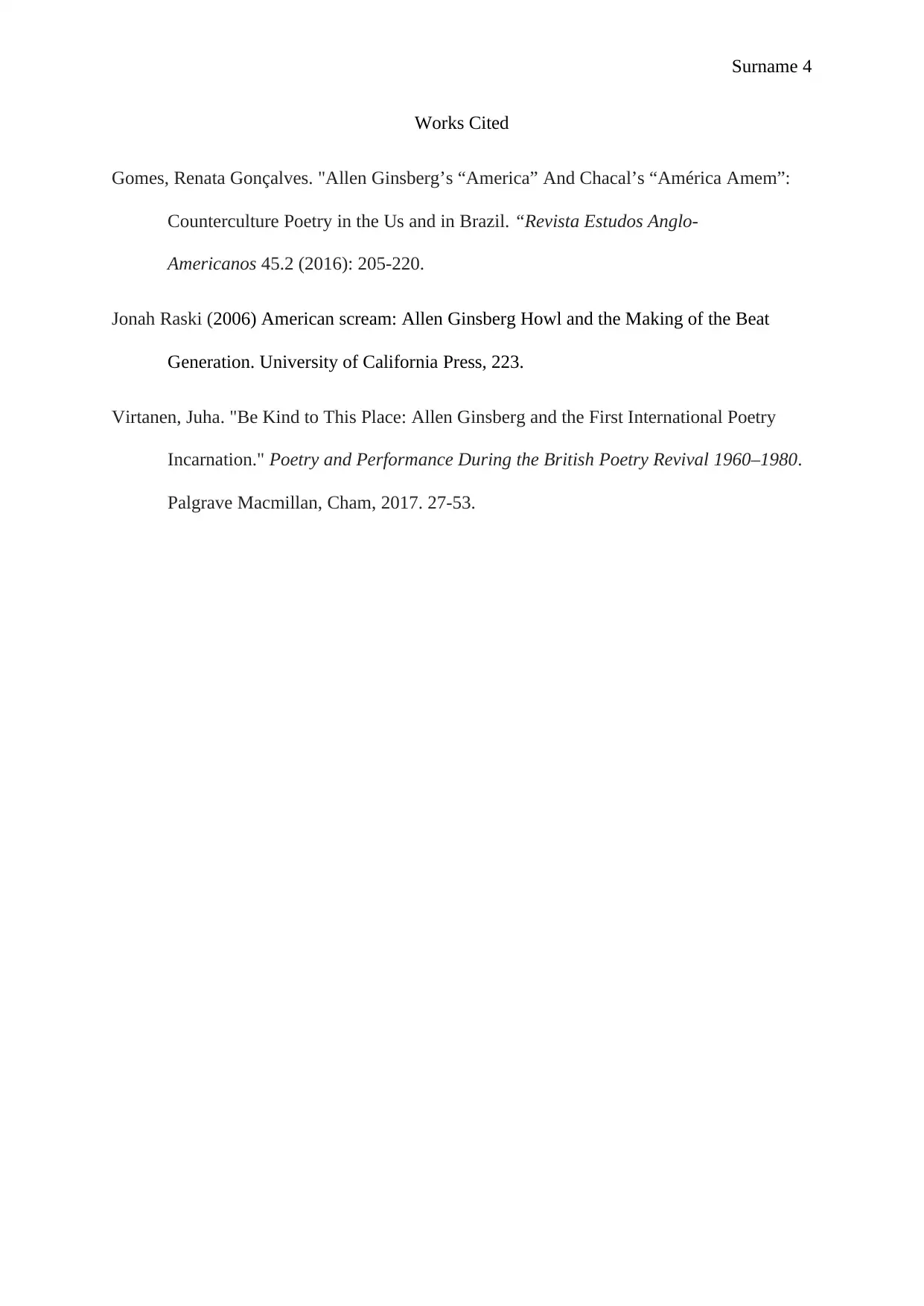Literary Research Paper: Analyzing Allen Ginsberg's Howl
VerifiedAdded on 2023/06/10
|4
|1001
|260
Essay
AI Summary
This literary research paper analyzes Allen Ginsberg's iconic poem, 'Howl,' published in 1956. The paper explores the poem's historical context, themes of materialism, conformity, and oppression, and its dedication to Carl Solomon. It delves into the poem's structure, divided into three parts, and examines the use of literary techniques such as anaphora and symbolism. The analysis highlights the poem's significance as a cry of the Beat Generation, reflecting the social, economic, and political realities of America. The paper discusses the controversies surrounding the poem and its impact on challenging the status quo. It examines the poem's reflection of societal issues like sexual norms, gender awareness, and artistic expression. The conclusion emphasizes the poem's enduring relevance and the complexities of its themes.

Surname 1
Name:
Tutor:
Course:
Date:
LITERARY RESEARCH PAPER:
Introduction
Howl was published in the year his 1956 collection by Allen Ginsburg. The poem that
he wrote about how his friend's destruction of their generation and how the theme of
materialism and the conformity was dominating at that particular time in the United States. It
was written as a special dedication to Carl Solomon (Jonah Raski 223). Allen reportedly
writes this poem in a coffee shop in California Berkeley. A series of events happen before he
decides to pen down Howl. In American literature and history, the poem Howl is considered
one of the most significant compositions ever made. Divided into three parts, the poem is
engaging. Through his poetry, the theme of oppression emerges. The opening line gives a
reader a tip of what kind of world we need to prepare ourselves to see” the best minds of my
generation destroyed by madness, starving….”
Discussions
Within the poem, several themes arise as well as techniques. Being divided into parts,
The tone used in verse is a sad and elegiac tone. A clear indication of a deep cry
hence the title, Howl. In America in an era where capitalism was dominating, and oppression
and subjugation were commonly practiced, the poem was the cry of the beat generation that
somehow was looking for a way to deliver themselves. The poem by Allen is set to seeking
Name:
Tutor:
Course:
Date:
LITERARY RESEARCH PAPER:
Introduction
Howl was published in the year his 1956 collection by Allen Ginsburg. The poem that
he wrote about how his friend's destruction of their generation and how the theme of
materialism and the conformity was dominating at that particular time in the United States. It
was written as a special dedication to Carl Solomon (Jonah Raski 223). Allen reportedly
writes this poem in a coffee shop in California Berkeley. A series of events happen before he
decides to pen down Howl. In American literature and history, the poem Howl is considered
one of the most significant compositions ever made. Divided into three parts, the poem is
engaging. Through his poetry, the theme of oppression emerges. The opening line gives a
reader a tip of what kind of world we need to prepare ourselves to see” the best minds of my
generation destroyed by madness, starving….”
Discussions
Within the poem, several themes arise as well as techniques. Being divided into parts,
The tone used in verse is a sad and elegiac tone. A clear indication of a deep cry
hence the title, Howl. In America in an era where capitalism was dominating, and oppression
and subjugation were commonly practiced, the poem was the cry of the beat generation that
somehow was looking for a way to deliver themselves. The poem by Allen is set to seeking
Paraphrase This Document
Need a fresh take? Get an instant paraphrase of this document with our AI Paraphraser

Surname 2
transcendent reality of the happenings in America social, economic and political life (Gomes
220).
Part one of the poem talks about the minds of his generations how the minds of young
people are being wasted. From the line; “cry that shivers the cities down to the last radio.” he
deems his work as giving voice to the voiceless, a part of a society that was silence and
deprived of their rights. From verse 1 to verse 76, he expresses his cry, and ideally, he
emphasizes on the need for “free speech for the emotional expression” A common phrase he
borrowed from Walt Whitman. Social, religious and sexual identity is the constant theme in
the first part. This even gets Allen to be criticized by other poets and literary writers on his
view upon describing the generation as devouring madness. In my opinion, Anaphora is a
technique Allen commonly used; it is the repetition of words, phrases, and lines. IN the first
part we see the use of the word “who” for emphasis.Part two of the poem, Symbolism seems
to be a constant theme. The word which is used in reference and a god Moloch is also used to
symbolize the American capitalism effect upon the children of the land. This even results in
devastating militia effects (Juha 53).
Part three of the poem, as mentioned earlier, writing howl happened after a series of
event. Allen Ginsberg’s life. The third part is a special dedication to Carl Solomon who is his
colleague and had met earlier, in 1949. His commitment is about a revolution, more of
cultural awareness. Allen had an experience as a gay man, and this gave him credit to write
about the blooming sexuality in the 1940s and 1950s an era where such sexual discoveries
were coming to light and people fighting for their rights. Allen Ginsberg and James Baldwin
being the activists who saw it wise through literary work of how they could revolutionize the
society; A Beat Generation that needs free thinking and to is freed from the societal
expectations and oppressions (Juha 53).
transcendent reality of the happenings in America social, economic and political life (Gomes
220).
Part one of the poem talks about the minds of his generations how the minds of young
people are being wasted. From the line; “cry that shivers the cities down to the last radio.” he
deems his work as giving voice to the voiceless, a part of a society that was silence and
deprived of their rights. From verse 1 to verse 76, he expresses his cry, and ideally, he
emphasizes on the need for “free speech for the emotional expression” A common phrase he
borrowed from Walt Whitman. Social, religious and sexual identity is the constant theme in
the first part. This even gets Allen to be criticized by other poets and literary writers on his
view upon describing the generation as devouring madness. In my opinion, Anaphora is a
technique Allen commonly used; it is the repetition of words, phrases, and lines. IN the first
part we see the use of the word “who” for emphasis.Part two of the poem, Symbolism seems
to be a constant theme. The word which is used in reference and a god Moloch is also used to
symbolize the American capitalism effect upon the children of the land. This even results in
devastating militia effects (Juha 53).
Part three of the poem, as mentioned earlier, writing howl happened after a series of
event. Allen Ginsberg’s life. The third part is a special dedication to Carl Solomon who is his
colleague and had met earlier, in 1949. His commitment is about a revolution, more of
cultural awareness. Allen had an experience as a gay man, and this gave him credit to write
about the blooming sexuality in the 1940s and 1950s an era where such sexual discoveries
were coming to light and people fighting for their rights. Allen Ginsberg and James Baldwin
being the activists who saw it wise through literary work of how they could revolutionize the
society; A Beat Generation that needs free thinking and to is freed from the societal
expectations and oppressions (Juha 53).

Surname 3
Conclusion
For a poem that is in the hallmark of marking activist social importance globally, it
faced controversies and even taken to court for being too obscene. Upon proper analysis and
in-depth criticism, it indeed was a poem that people could learn from. It is categorized as a
poem that challenges the status quo hence the term Beat poetry. Allen Ginsburg addresses the
negative aspects of human life. The madness he describes as fully engulfing his generational
mind is based on reality. The sexual norms, the societal expectation, gender awareness and
capitalism, drug usage as well as artistic expression. His last line establishes the essence of
closure and that solidarity at times can be both good and evil that is also a useful analysis
feature (Gomes 220).
In my opinion, Anaphora is a technique Allen commonly used; it is the repetition of
words, phrases, and lines. In the first part, we see the use of the word “who” for emphasis.
Figurative styles such as Anaphora, symbolism, victimization among other themes. All these
are just a reflection of how Allen Ginsburg saw the world he was living in through his
individualism and expressed it through his creativity.
Conclusion
For a poem that is in the hallmark of marking activist social importance globally, it
faced controversies and even taken to court for being too obscene. Upon proper analysis and
in-depth criticism, it indeed was a poem that people could learn from. It is categorized as a
poem that challenges the status quo hence the term Beat poetry. Allen Ginsburg addresses the
negative aspects of human life. The madness he describes as fully engulfing his generational
mind is based on reality. The sexual norms, the societal expectation, gender awareness and
capitalism, drug usage as well as artistic expression. His last line establishes the essence of
closure and that solidarity at times can be both good and evil that is also a useful analysis
feature (Gomes 220).
In my opinion, Anaphora is a technique Allen commonly used; it is the repetition of
words, phrases, and lines. In the first part, we see the use of the word “who” for emphasis.
Figurative styles such as Anaphora, symbolism, victimization among other themes. All these
are just a reflection of how Allen Ginsburg saw the world he was living in through his
individualism and expressed it through his creativity.
⊘ This is a preview!⊘
Do you want full access?
Subscribe today to unlock all pages.

Trusted by 1+ million students worldwide

Surname 4
Works Cited
Gomes, Renata Gonçalves. "Allen Ginsberg’s “America” And Chacal’s “América Amem”:
Counterculture Poetry in the Us and in Brazil. “Revista Estudos Anglo-
Americanos 45.2 (2016): 205-220.
Jonah Raski (2006) American scream: Allen Ginsberg Howl and the Making of the Beat
Generation. University of California Press, 223.
Virtanen, Juha. "Be Kind to This Place: Allen Ginsberg and the First International Poetry
Incarnation." Poetry and Performance During the British Poetry Revival 1960–1980.
Palgrave Macmillan, Cham, 2017. 27-53.
Works Cited
Gomes, Renata Gonçalves. "Allen Ginsberg’s “America” And Chacal’s “América Amem”:
Counterculture Poetry in the Us and in Brazil. “Revista Estudos Anglo-
Americanos 45.2 (2016): 205-220.
Jonah Raski (2006) American scream: Allen Ginsberg Howl and the Making of the Beat
Generation. University of California Press, 223.
Virtanen, Juha. "Be Kind to This Place: Allen Ginsberg and the First International Poetry
Incarnation." Poetry and Performance During the British Poetry Revival 1960–1980.
Palgrave Macmillan, Cham, 2017. 27-53.
1 out of 4
Your All-in-One AI-Powered Toolkit for Academic Success.
+13062052269
info@desklib.com
Available 24*7 on WhatsApp / Email
![[object Object]](/_next/static/media/star-bottom.7253800d.svg)
Unlock your academic potential
Copyright © 2020–2025 A2Z Services. All Rights Reserved. Developed and managed by ZUCOL.